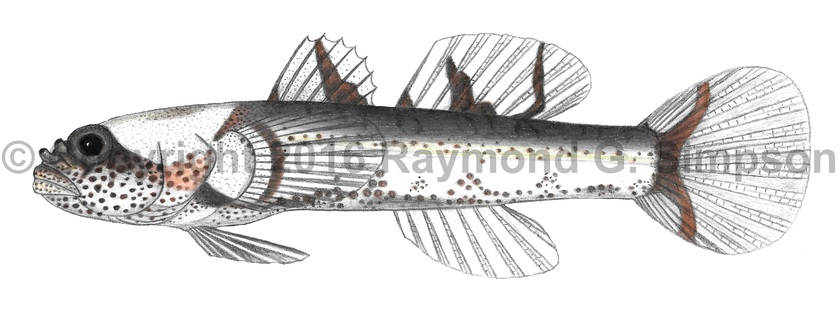
Common Name
Toadfish Goby
Year Described
Böhlke, 1963
Identification
Dorsal Fin: VII, 9-10
Anal Fin: 7-8
Pectoral Fin: 15-16
Caudal Fin: 17 segmented rays
Vertebrae: 11+16= 27 (total)
Body elongate with a flattened, rounded head (like a toadfish). Eye medium sized. Anterior dorsal spines not elongate. Pelvic fin rays 1-4 branched with the last shorter than fourth ray. Pelvic fins not fused and does not reach anus. One anal-fin pterygiophore anterior to the first haemal spine. Papillae rows 5i and 5s separate. Cephalic lateralis pores absent. Body naked. No basicaudal scales.
Color
Body pale translucent whitish on the lower two-thirds of body and quickly diffusing into black along the dorsal one-third. Head strikingly bicolored: a dark oblique stripe from eyes running to below pectoral base, the back of head bright whitish, and the snout brown with heavy melanophore speckling. White area on head round and obvious from above. Degree of black pattern increases with size. Heavy marbling of melanophores on belly running up the sides in places. First dorsal fin with a dark oblique bands. Second dorsal fin with two oblique bands. Anal and pelvic fins unmarked. Caudal fin clear with a dark band fused with the body markings. Pectoral fin white basally, clear distally, with a dark band separating the two regions. Eye black.
Size
Maximum size to 18mm SL.
Habitat
Inhabits shallow coral reefs in rubble areas (<5m).
Range
Widespread in the Caribbean Sea: the Bahamas to the Lesser Antilles.
References
Tornabene, L., J.L. Van Tassell, R.G. Gilmore, D.R. Robertson, F. Young, & C.C. Baldwin. 2016. Molecular phylogeny, analysis of character evolution, and submersible collections enable a new classification of a diverse group of gobies (Teleostei: Gobiidae: Nes subgroup), including nine new species and four new genera. Zoological Journal of the Linnean Society.
Other Notes
Phylogenetically divergent from the clade containing other Psilotris species, and so moved out of that genus by Tornabene et al. (2016). This genus is monotypic and quite distinctive in pattern and overall low meristics.